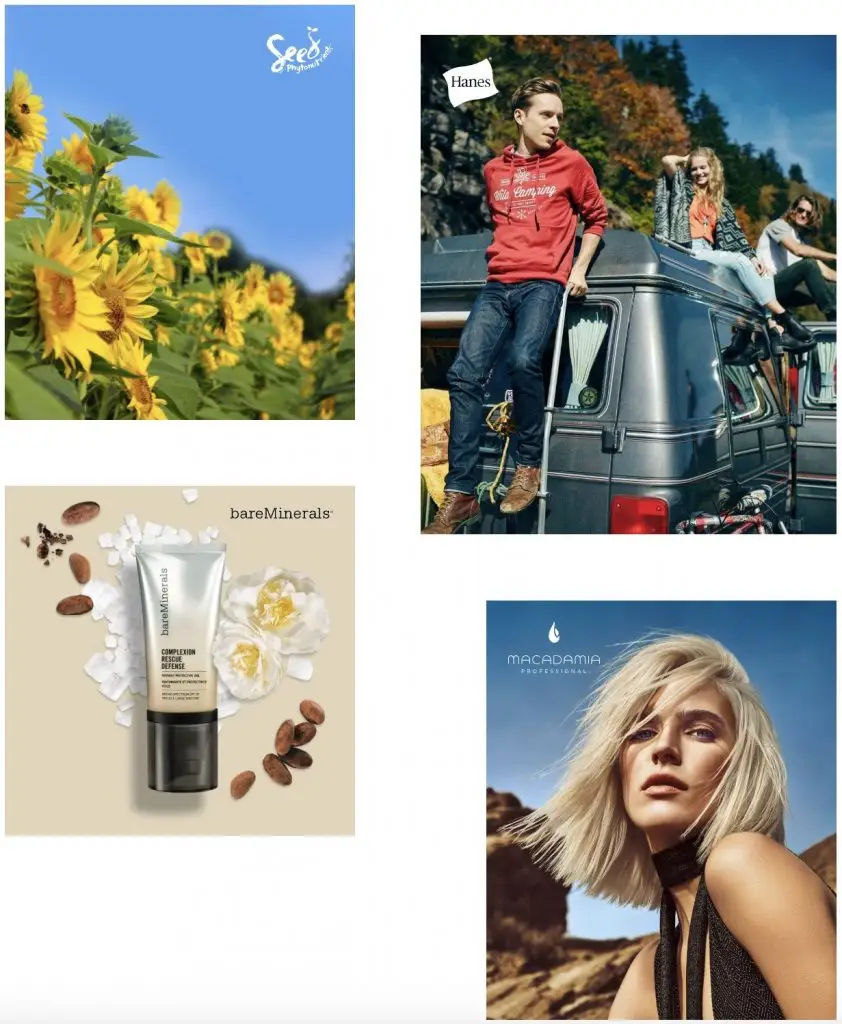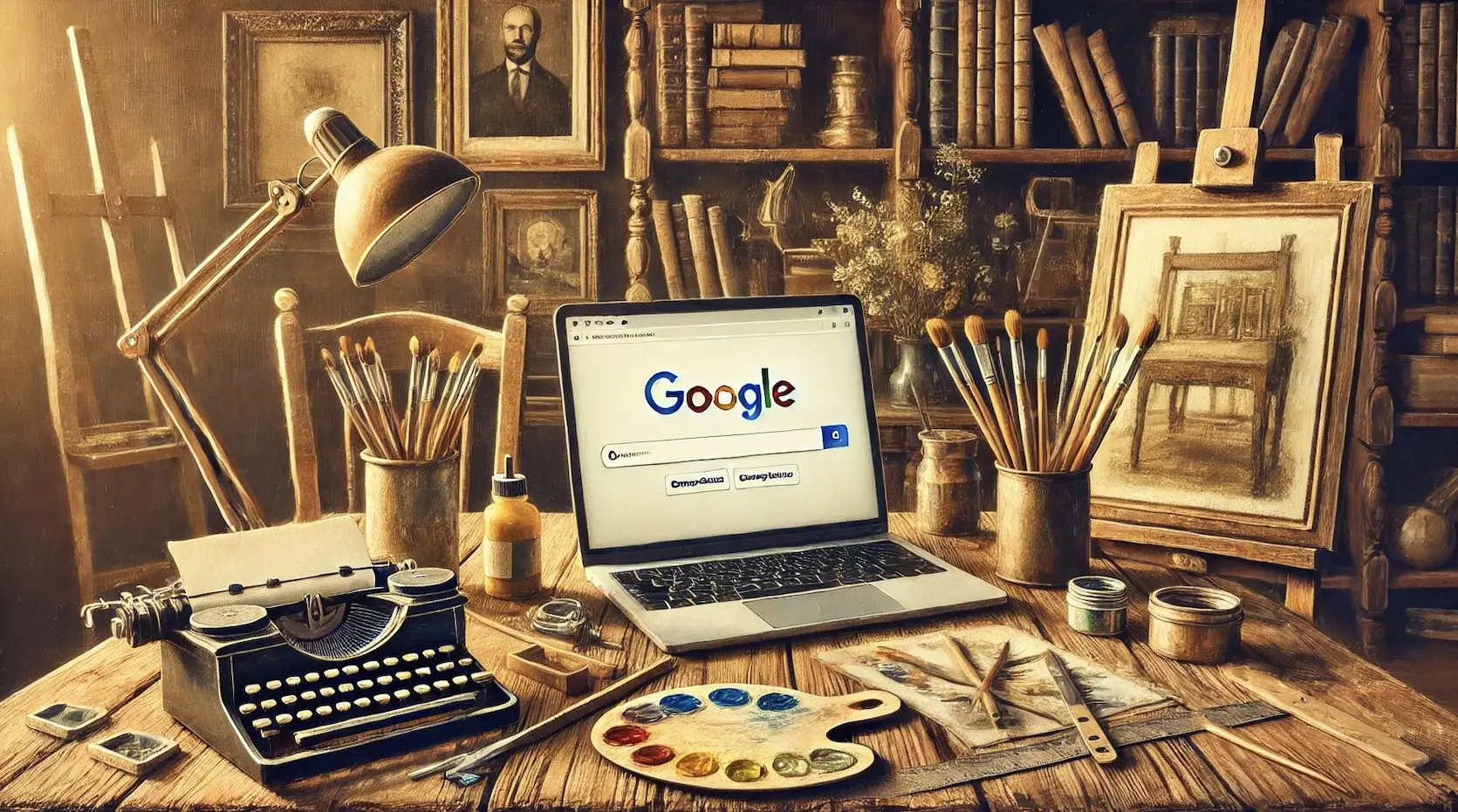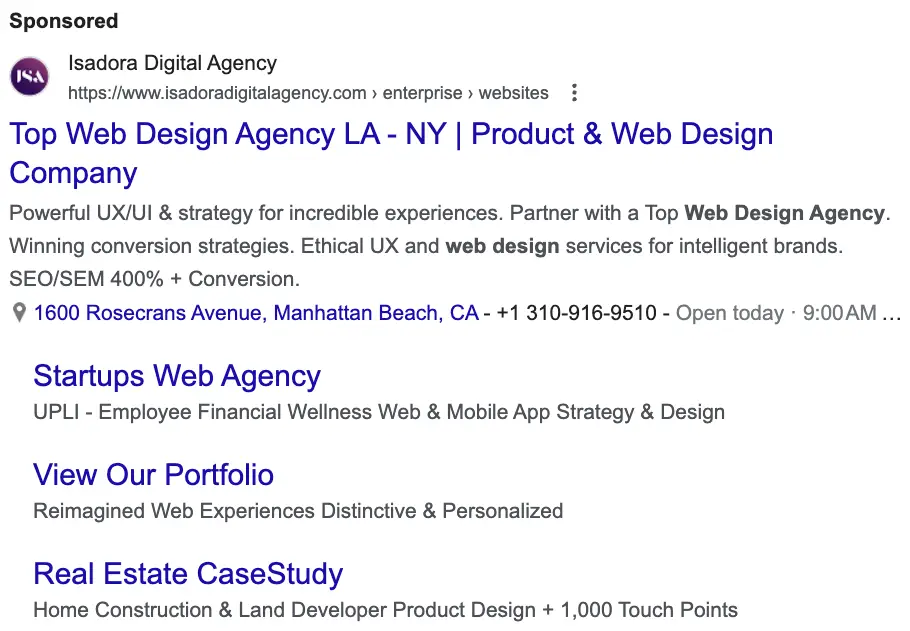
Demographics: Targeting the Right Audience for Web Design Agencies
For web design agencies, effective demographic targeting in Google Ads is essential to attract clients who truly need and value your services.
Unlike generic businesses, web design agencies must focus on demographics that align with decision-makers in industries or organizations that frequently outsource web design.
Here’s how to tailor your demographic approach:
Age and Professional Status
The ideal demographic often includes individuals aged 30–55, as this group typically consists of business owners, marketing managers, or startup founders—key decision-makers who are likely to invest in web design services.
Younger professionals may also be worth targeting if your agency specializes in working with startups or digital-first businesses.
Income Levels and Purchasing Power
Web design projects can range from modest to premium budgets. By leveraging Google Ads’ income-based targeting, focus on higher-income brackets to attract clients who can afford professional, custom design services.
This is particularly useful if your agency specializes in high-end, bespoke designs or enterprise-level solutions.
Industry-Specific Personas
Analyze which industries generate the majority of your leads and tailor demographic filters accordingly. For instance:
- E-commerce business owners: Typically in the 25–45 age range, often with a strong digital presence.
- Local service providers: May skew slightly older, often between 35–55.
- Non-profits or education sectors: Focus on managers or administrators who might be in their mid-30s or older.
Geographic and Cultural Considerations
Geographic targeting complements demographic strategies by identifying where your ideal clients are likely based. For instance:
- Target urban areas with a high density of small businesses and startups.
- Use cultural data to refine demographics for businesses that require culturally specific designs (e.g., agencies targeting bilingual clients or international audiences).
Behavioral and Interest Insights
Though technically not demographics, aligning interests and behaviors with your demographic strategy can significantly improve results. For example:
- Target decision-makers who have previously searched for web hosting, branding services, or online marketing tools, as these signals often overlap with the need for web design.
Use Custom Audiences for B2B Segmentation
Many decision-makers may not list their exact industry or position on their Google profiles, but creating a custom audience using job titles, industries, or search behaviors can help fine-tune demographic targeting.
For web design agencies, this might include:
- “Small Business Owners”
- “Marketing Professionals”
- “Tech Entrepreneurs”
By integrating these demographic nuances into your Google Ads strategy, you can reach an audience that not only needs web design services but also values the unique expertise your agency offers.
Campaign/Ad Group Structure: Maximizing Results for Web Design Agencies
A well-organized campaign and ad group structure is critical for web design agencies to achieve high performance in Google Ads.
This ensures that your ads speak directly to the needs of your target audience while maximizing relevance and budget efficiency.
Here’s how to tailor your campaign and ad group structure specifically for web design services:
Segment Campaigns by Service Categories
Web design agencies often offer a variety of services—each with distinct target audiences and search intents. Separate your campaigns based on these service categories to ensure laser-focused targeting.
Examples include:
- Custom Website Design
- E-commerce Website Development
- Website Redesign Services
- UX/UI Consulting
Each campaign can then have ad groups further breaking down subcategories, such as platforms (WordPress, Shopify) or specific client types (small businesses, startups, enterprises).
Use Geographic Campaign Structuring for Local Agencies
If your agency caters to local businesses or specific regions, structure campaigns by geographic area. For instance:
- Campaign 1: Web Design for NYC Businesses
- Campaign 2: Web Design for LA Startups
This enables more precise targeting and allows you to tailor ad language to the local market, such as referencing city-specific needs or challenges.
Dynamic Campaigns for Platform-Specific Services
Many clients look for platform-specific expertise, such as WordPress, Squarespace, or Shopify development. Set up ad groups dedicated to these platforms:
- Ad Group 1: WordPress Web Design
- Ad Group 2: Shopify Store Setup
- Ad Group 3: Squarespace Portfolio Design
Using platform-specific keywords ensures that you capture leads actively seeking specialized services.
Dedicated Campaigns for Retargeting and Upselling
In addition to prospecting campaigns, allocate budget to retargeting past website visitors or upselling existing clients:
- Retargeting Campaign: Show ads to potential clients who visited your pricing page but didn’t convert.
- Upselling Campaign: Advertise services like maintenance packages, SEO optimization, or redesigns to past clients.
By keeping these campaigns separate, you can fine-tune budgets and strategies based on different stages of the customer journey.
Ad Group Segmentation by Client Needs
Within each campaign, create ad groups that directly address specific client pain points or goals. For example:
Ad Group 1: “Small Business Web Design”
Focused on budget-friendly, scalable solutions for small businesses.
Ad Group 2: “Enterprise Web Solutions”
Highlighting premium, tailored solutions for corporate clients.
Ad Group 3: “E-commerce Store Setup”
Targeting businesses looking to launch or upgrade their online stores.
By aligning ad groups with distinct client needs, you can craft highly relevant ad copy and landing pages that resonate with specific segments.
Test Niche Ad Groups for High-Converting Niches
If your agency has expertise in niche markets—such as healthcare, real estate, or non-profits—create dedicated ad groups targeting these industries. For instance:
- Ad Group: “Web Design for Real Estate”
- Ad Group: “Non-Profit Web Design”
This allows you to test niche campaigns while showcasing your specialization, which can lead to higher conversion rates.
Keyword Mapping for Precise Ad Groups
Web design agencies often deal with varied search intents, from informational queries (e.g., “how much does a website cost?”) to high-intent queries (e.g., “best web design agency near me”).
Map keywords to specific ad groups:
- Informational Queries Ad Group: Create ads and landing pages offering value-packed resources, like blog posts or guides.
- Transactional Queries Ad Group: Focus on high-intent terms, directing users to service-specific landing pages or free consultation offers.
This structure helps avoid keyword cannibalization while improving Quality Scores.
Ads Types/Formats: Tailoring Formats for Web Design Agencies
For web design agencies, selecting the right ad types and formats in Google Ads is crucial to showcasing your expertise and attracting the right clients.
The visual and service-driven nature of web design lends itself to specific ad formats that can effectively communicate your value.
Here’s how to leverage these formats to maximize impact:
Search Ads: Target High-Intent Clients
Search ads are a cornerstone for web design agencies because they reach users actively searching for services. To maximize effectiveness:
- Service-Specific Keywords: Craft ads targeting specific client needs like “custom web design for startups” or “e-commerce website development.”
- Ad Extensions for Detail: Use callout extensions to highlight expertise, such as “Award-Winning Designs” or “Free Consultation.”
- Structured Snippets: Display a list of offered services, such as WordPress design, UX/UI consulting, or responsive design.
This format excels at capturing high-intent traffic and converting leads ready to engage.

Display Ads: Showcase Your Work Visually
Responsive display ads allow web design agencies to highlight their portfolio visually, appealing to potential clients exploring options:
- Use Stunning Portfolio Images: Include visuals of completed projects, emphasizing diverse styles (e.g., corporate, creative, and e-commerce).
- Strong Value Propositions: Headlines like “Custom Web Design that Converts” help communicate expertise.
- Target Industry-Specific Audiences: Display ads can be tailored to industries where you specialize, like healthcare or education.
Display ads are excellent for building brand awareness and showcasing creativity.
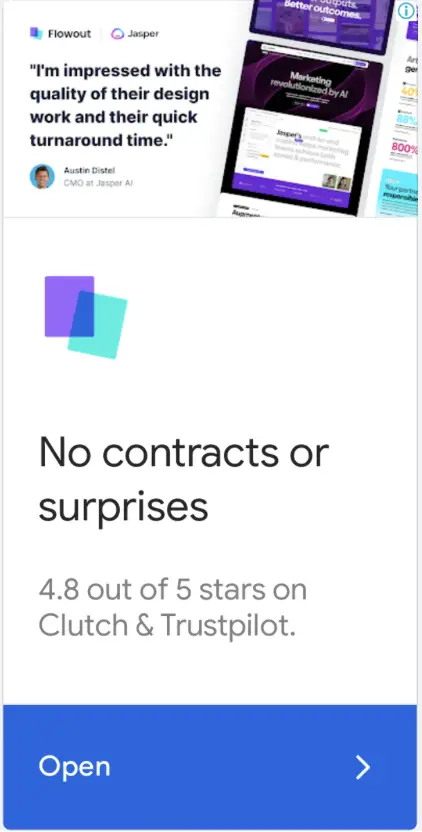
Video Ads: Tell a Story
Video ads are a powerful way for web design agencies to highlight their process, success stories, and portfolio. Platforms like YouTube provide excellent visibility:
- Showcase Transformative Results: Highlight before-and-after designs to demonstrate your ability to elevate businesses online.
- Explain Your Process: Create short videos that outline how you approach web design, from research to delivery.
- Feature Client Testimonials: Videos of satisfied clients discussing their improved online presence can significantly build trust.
This format is especially effective when targeting businesses that value storytelling and creativity.
Dynamic video of a Dallas Web Design Agency
Performance Max Ads: All-in-One Visibility
Performance Max campaigns offer a versatile way to combine search, display, video, and discovery ads. For web design agencies:
- Highlight Unique Selling Points: Include visuals, headlines, and descriptions that showcase specialties like “E-commerce Web Design Experts” or “Local Business Specialists.”
- Goal-Oriented Campaigns: Use Performance Max to drive consultations or signups for free website audits.
- Dynamic Content for Niche Audiences: Automatically adapt creatives to fit specific industries or client profiles.
This format maximizes reach and consolidates efforts across multiple channels.

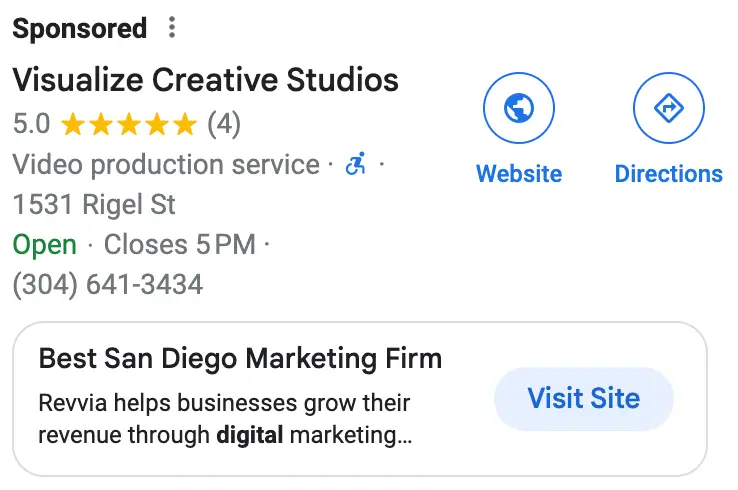
Discovery Ads: Engaging Browsing Audiences
Discovery ads are a perfect fit for web design agencies aiming to capture potential clients who are exploring options on Google Discover, YouTube, or Gmail:
•Showcase Designs That Inspire: Include portfolio visuals that catch the eye during casual browsing.
•Drive Curiosity with Headlines: Use intriguing headlines like “Your Next Website, Designed to Convert.”
•Target Decision-Makers: Focus on business owners, marketing professionals, and startup founders.
This format is excellent for expanding brand awareness and attracting prospects who are not yet actively searching for services.
Audience: Building Precise Client Profiles for Web Design Agencies
For web design agencies, identifying and targeting the right audiences in Google Ads goes beyond simple demographics or keyword targeting.
The focus should be on understanding and leveraging user behaviors, interests, and intent to connect with potential clients at various stages of their decision-making journey.
By building precise audience profiles tailored to the web design industry, you can significantly enhance the relevance and performance of your campaigns.
In-Market Audiences for Business Services
Google Ads provides in-market audiences that align with users actively seeking services like web design. For web design agencies:
Relevant In-Market Audiences: Target groups such as “Business Services,” “Advertising & Marketing Services,” or “Web Hosting.”
These audiences allow you to capture users who are already in the process of evaluating or purchasing related services.
Affinity Audiences to Establish Brand Awareness
Affinity audiences let you reach users based on long-term interests or habits. For web design agencies:
Target Entrepreneurs or Business Builders: Use affinity audiences like “Small Business Owners” or “Startup Enthusiasts.”
This approach works well for building awareness and planting the seed for future conversions.
Custom Audiences Based on Search Behavior
Custom audiences allow you to define groups based on users’ search history and online activity. For a web design agency:
Create Custom Segments: Build audiences of users who searched for specific terms like “affordable website design,” “best website for e-commerce,” or “redesign my site.”
Custom audiences are particularly effective for reaching users with immediate needs and high conversion potential.
Life Events to Reach Decision-Makers at Key Moments
Google’s life events targeting allows you to connect with users during significant milestones. For web design agencies:
Relevant Life Events: Target individuals starting a new business or opening a new location, as these moments often trigger the need for professional web design services.
This strategy ensures your ads are highly relevant to users experiencing pivotal moments that align with your services.
Engage with Website Visitors Using Remarketing
Remarketing is essential for web design agencies to stay top-of-mind for potential clients who didn’t convert initially:
Segment Your Audience: Create lists for users who visited your portfolio, pricing, or service pages.
Remarketing ensures you’re consistently re-engaging users who have already expressed interest in your services.
Combine Interests with Business Needs
Web design services are often sought by individuals balancing creative vision with business goals. To capture this dual audience:
- Interest-Based Audiences: Target users interested in “Design,” “Technology,” or “Entrepreneurship.”
- Combine Interests and Intent: For example, a user interested in “Design” and actively searching for “site redesign” is a strong candidate for conversion.
This dual-targeting strategy allows you to reach both practical and visionary decision-makers.
Audience Exclusions to Refine Results
To ensure your ads focus on the right prospects, exclude irrelevant audiences that don’t align with your business goals:
- Exclude Job Seekers: Prevent your ads from targeting individuals searching for “web designer jobs” instead of web design services.
- Filter Out Unqualified Leads: Use audience exclusions to avoid reaching users with low buying intent, such as students or hobbyists.
Audience exclusions help refine your targeting, maximizing the efficiency of your campaigns.
Keywords: Crafting a Strategy for Web Design Agencies
Selecting and optimizing the right keywords is a cornerstone of any successful Google Ads campaign for web design agencies.
The challenge lies in identifying search terms that resonate with potential clients at different stages of their buying journey, from those exploring options to those ready to hire.
For web design agencies, this requires a focused and strategic approach to keywords that align with client needs, industry nuances, and specific services.
Focus on High-Intent Keywords
High-intent keywords indicate that the searcher is actively looking for a service provider. For web design agencies, these keywords often include:
- “Custom web design agency”
- “Professional website design services”
- “E-commerce website development near me”
- “Website redesign experts”
These terms are more likely to attract users who are ready to engage and convert into clients. Pair them with ad copy that highlights your expertise and a clear call to action.
Incorporate Service-Specific Keywords
Web design agencies typically offer a range of services. Use service-specific keywords to align with client search behavior. For example:
- “Responsive web design services” for agencies focused on mobile-friendly sites.
- “WordPress website developers” to target clients seeking platform-specific expertise.
- “SEO-friendly web design” for businesses prioritizing search visibility.
Segment these keywords into their own ad groups for tailored ads and landing pages, which can boost relevance and Quality Scores.
Target Industry-Specific Keywords
Many businesses look for agencies that specialize in their industry. Include keywords that reflect this demand, such as:
- “Web design for real estate agents”
- “Healthcare website development services”
- “Restaurant website design agency”
By emphasizing industry expertise, you can position your agency as a trusted partner for clients in niche markets.
Leverage Local Keywords for Geographic Targeting
If your agency serves specific regions or cities, focus on localized keywords to attract clients in those areas. Examples include:
- “Web design agency in [City Name]”
- “Best web designers near me”
- “Affordable website development in [Region]”
Local keywords not only boost relevance but also help smaller businesses find and connect with your agency.
Use Long-Tail Keywords for Precision Targeting
Long-tail keywords are typically more specific and less competitive, making them ideal for web design agencies aiming to capture niche audiences. Examples might include:
- “Affordable website redesign for small businesses”
- “Custom e-commerce website developer for startups”
- “SEO-optimized web design for lawyers”
These keywords often indicate higher purchase intent and can improve conversion rates while keeping cost-per-click manageable.
Address Client Pain Points in Keyword Selection
Think about the challenges your potential clients face and target keywords that reflect their concerns. For example:
- “Fix slow website design”
- “Update outdated website layout”
- “Improve website user experience”
By addressing pain points, you attract clients who are actively seeking solutions to their problems.
Negative Keywords to Avoid Unqualified Clicks
To maximize your ad spend, it’s critical to exclude irrelevant search terms. Common negative keywords for web design agencies might include:
- “Free website templates”
- “DIY website builders”
- “Web design jobs”
Adding these to your campaigns helps focus your budget on users with higher buying intent.
Ad Content: Crafting Compelling Ads for Web Design Agencies
For web design agencies, creating effective ad content means showcasing creativity, expertise, and results in a way that resonates with potential clients.
Your ad copy, images, and videos should reflect your agency’s ability to deliver stunning, functional websites while addressing specific client needs.
This section dives into strategies for creating ad content tailored to the web design industry.
Headline Copy: Showcase Expertise and Value
Your headlines need to immediately capture attention and convey your value proposition. Focus on outcomes and expertise that matter to your target audience:
- “Custom Websites That Drive Conversions”
- “Professional Web Design for Small Businesses”
- “E-commerce Websites Built to Sell”
Avoid generic phrases like “Best Web Design Agency” and instead highlight what sets your agency apart, such as expertise in specific industries, fast turnaround times, or affordability.
Description Copy: Address Client Pain Points
Your description text should elaborate on how your agency solves common challenges faced by potential clients. Examples include:
- “Struggling with an outdated website? We create modern, responsive designs tailored to your business.”
- “Boost sales with a professionally designed e-commerce store optimized for mobile and desktop users.”
- “Get a free website audit and discover how we can improve your online presence.”
Addressing pain points like outdated designs, low conversion rates, or poor user experience demonstrates that you understand your clients’ needs.
Call-to-Actions: Drive Immediate Engagement
Strong CTAs are essential for motivating potential clients to take the next step. Tailor your CTAs to your specific services and target audience:
- “Request Your Free Web Design Consultation Today”
- “View Our Portfolio and See the Results”
- “Get a Custom Website Quote in Minutes”
Emphasize urgency and value to encourage users to act quickly.
Images: Showcase Visual Expertise
Images are a critical part of ad content for web design agencies, as they allow you to demonstrate your skills visually. Use high-quality screenshots of:
- Before-and-After Transformations: Show how you revamped a client’s outdated website.
- Portfolio Highlights: Include diverse examples of websites you’ve designed for different industries.
- Responsive Designs: Highlight how your websites look on various devices (desktop, tablet, mobile).
Ensure all images are clean, professional, and optimized for quick loading to maintain quality across platforms.
Videos: Tell a Story
Video content is a powerful way to engage potential clients and showcase your process, results, or client testimonials. Ideas for video content include:
- Case Studies: Walk viewers through the story of a successful project, including challenges, solutions, and results.
- Explainer Videos: Highlight your process, such as research, prototyping, and final delivery.
- Client Testimonials: Feature satisfied clients discussing how your services improved their business.
Keep videos concise, visually engaging, and focused on the value your agency provides.
Ad Content for Industry-Specific Campaigns
If you target specific industries, tailor your ad content to speak directly to those audiences. Examples include:
- For e-commerce businesses: “Turn browsers into buyers with custom e-commerce designs.”
- For healthcare providers: “HIPAA-compliant websites built for patient trust.”
- For real estate agents: “Showcase properties with interactive, mobile-friendly designs.”
Industry-specific messaging builds credibility and demonstrates your understanding of niche needs.
Dynamic Content for Personalized Messaging
Dynamic ad content can help deliver personalized messaging based on user behavior or search intent. For instance:
- Display ads that dynamically showcase portfolio pieces relevant to the user’s industry.
- Include tailored CTAs, such as “Get a Custom Quote for Your Law Firm Website.”
This approach ensures that your ads feel highly relevant and targeted.
Highlight Unique Selling Points
Your ad content should emphasize what makes your agency unique. These might include:
- “Free Website Audits for New Clients”
- “Launch Your Site in 7 Days with Our Fast-Track Service”
- “Award-Winning Designs Backed by SEO Expertise”
Unique selling points help you stand out in a competitive landscape and attract high-value clients.
Extensions: Maximizing Impact for Web Design Agencies
Extensions are a critical element of Google Ads campaigns, offering web design agencies additional opportunities to enhance ad performance, convey value, and capture client interest.
By strategically using extensions tailored to the web design industry, you can improve ad visibility, click-through rates, and conversions. Below are specific tips and best practices for utilizing extensions effectively.
Sitelink Extensions: Highlight Key Services
Sitelink extensions allow you to showcase additional pages of your website directly within your ad. For web design agencies, these links can direct users to high-value pages that address specific client needs:
“View Our Portfolio” linking to a showcase of your previous work.
- “Explore E-commerce Solutions” directing to a page dedicated to online store development.
- “Get a Free Website Audit” linking to a lead capture form.
- “Our Web Design Process” providing insight into how you work.
These links not only improve navigation but also highlight your agency’s expertise and range of services.
Callout Extensions: Emphasize Unique Selling Points
Callout extensions are ideal for showcasing what sets your agency apart. Use them to highlight features and benefits such as:
- “Award-Winning Designs”
- “Responsive Mobile-Friendly Sites”
- “SEO-Optimized Development”
- “Free Initial Consultation”
This extension is a great way to add extra value to your ads without taking up headline or description space.
Structured Snippets: Detail Your Service Offerings
Structured snippets allow you to organize and display specific categories of your services, giving users an at-a-glance view of what you offer. For a web design agency, this could include:
- Service Types: Custom Design, Website Redesign, E-commerce Development, UX/UI Optimization.
- Industries Served: Real Estate, Healthcare, E-commerce, Startups.
- Platform Expertise: WordPress, Shopify, Wix, Squarespace.
Structured snippets help potential clients quickly assess whether your agency fits their needs.
Location Extensions: Attract Local Clients
For agencies targeting local businesses, location extensions can improve visibility by displaying your office address and a link to Google Maps directly in your ad. Benefits include:
- Making it easier for clients to find you.
- Building trust by emphasizing your presence in the local market.
- Allowing users to quickly access directions or call your office.
This is particularly effective for agencies that offer in-person consultations or workshops.
Call Extensions: Simplify Lead Generation
Call extensions enable potential clients to call your agency directly from the ad, especially valuable for users on mobile devices. Best practices include:
- Using a dedicated phone line for ad campaigns to track leads.
- Setting call extensions to display during business hours to ensure you can respond promptly.
- Including a strong CTA in the ad copy, such as “Call Now for a Free Consultation.”
This extension is an excellent tool for capturing high-intent leads who want immediate contact.
Image Extensions: Showcase Your Work
Image extensions allow you to visually enhance your ad with compelling visuals. For web design agencies, these could include:
- Screenshots of standout projects or client websites.
- Before-and-after comparisons showing redesign transformations.
- Collages that demonstrate your versatility across industries.
Well-chosen images make your ads more engaging and provide immediate proof of your agency’s capabilities.
Price Extensions: Highlight Transparent Pricing
If your agency offers packaged services or clear pricing tiers, price extensions can make your offerings more attractive. Examples include:
- “Basic Website Design – $1,500”
- “E-commerce Development – Starting at $3,000”
- “Website Redesign – $2,000 Flat Rate”
Transparent pricing builds trust and can help filter out leads that may not align with your pricing structure.
Lead Form Extensions: Capture Interest Directly
Lead form extensions allow users to submit inquiries without leaving the ad. This is perfect for capturing high-intent leads looking for immediate information or consultation. Use it to collect:
- Contact information for free consultations.
- Requests for quotes on specific projects.
- Sign-ups for newsletters or guides about improving website performance.
Pair the lead form with a strong incentive, like a free audit or consultation, to boost submissions.
App Extensions: Promote Web Design Tools
If your agency has a proprietary app or partners with tools like site analyzers or prototyping apps, app extensions can direct users to download or learn more about these tools. For example:
- “Download Our Site Audit App for Free”
- “Try Our Wireframe Tool to Plan Your Next Website”
This extension is a great way to showcase added value if technology plays a role in your service offering.
Promotion Extensions: Highlight Special Offers
Promotion extensions are an excellent way for web design agencies to attract attention and drive engagement by showcasing time-sensitive deals or discounts directly within your ad.
These extensions make your ads stand out while emphasizing value to potential clients.
Use Cases for Web Design Agencies:
- Seasonal Discounts: “Save 20% on Web Design Services – Limited Time Offer.”
- First-Time Client Deals: “Get 10% Off Your First Website Project.”
- Bundled Services: “Free SEO Audit with Every Website Redesign.”
- Event-Based Offers: “Exclusive Discount for Startups During [Event Name].”
Best Practices for Promotion Extensions:
- Add Specific Dates: Include start and end dates to create urgency, such as “Offer valid until [specific date].”
- Highlight High-Value Promotions: Focus on offers that resonate with your target audience, like reduced rates for new businesses or free consultations.
- Align with Landing Pages: Ensure the promotion is prominently displayed on your landing page to maintain consistency and build trust.

Landing Pages: Converting Traffic into Clients for Web Design Agencies
A well-designed landing page is essential for converting Google Ads traffic into leads or clients, particularly for web design agencies where aesthetics, functionality, and messaging play a pivotal role.
Since potential clients often judge your capabilities based on their first impression of your website, your landing page must reflect the quality and expertise you promise to deliver.
Here’s how to craft landing pages tailored to the needs of web design clients.
Tailor Landing Pages to Specific Services
Each Google Ads campaign or ad group should lead to a landing page that aligns with the specific service being promoted. For example:
- Custom Website Design Campaign: A page emphasizing bespoke design services, showcasing unique portfolio pieces and testimonials from satisfied clients.
- E-commerce Website Development Campaign: A page highlighting e-commerce success stories, features like shopping cart integration, and mobile optimization.
- Website Redesign Campaign: A page targeting businesses with outdated websites, featuring before-and-after project showcases.
By creating dedicated landing pages for each service, you increase relevance and improve the likelihood of conversions.
Showcase Your Portfolio Prominently
Your landing page should act as a visual portfolio, immediately demonstrating your expertise. Include:
- High-resolution screenshots of completed projects.
- Case studies that outline challenges, solutions, and results.
- Interactive elements, like carousels or clickable project thumbnails, for an engaging user experience.
For a web design agency, the portfolio is one of the strongest tools to convince prospects of your capabilities.
Include Clear, Action-Oriented CTAs
Your landing page must drive visitors to take action. Use CTAs that are specific to the services you’re promoting, such as:
- “Get a Free Website Audit Today”
- “Request a Custom Design Quote”
- “Schedule Your Free Consultation”
Ensure CTAs are visually prominent, placed above the fold, and repeated throughout the page in strategic locations.
Address Pain Points and Offer Solutions
Anticipate the concerns or needs of potential clients and address them directly on the landing page. Examples might include:
- “Is your outdated website driving away customers? We specialize in redesigns that convert.”
- “Struggling with poor mobile performance? Our responsive designs work seamlessly on any device.”
- “Need a website fast? Get a fully functional site in as little as 10 days.”
By speaking directly to your audience’s challenges, you position your agency as the ideal solution.
Build Trust with Social Proof
For web design agencies, trust is critical. Include elements that reassure visitors of your credibility:
- Client Testimonials: Feature quotes from happy clients, ideally accompanied by their logos or links to their websites.
- Certifications and Awards: Display any industry accolades or certifications that validate your expertise.
- Metrics: Highlight achievements like “50+ websites launched” or “98% client satisfaction rate.”
Social proof helps convince potential clients that your agency delivers reliable and high-quality results.
Optimize for Mobile and Speed
Given the increasing use of mobile devices, your landing page must be mobile-friendly and load quickly:
- Use responsive design to ensure the page looks great on any device.
- Compress images and optimize code to achieve fast loading times, especially for image-heavy portfolio sections.
A slow or poorly optimized page reflects negatively on your agency’s capabilities and can lead to lost leads.
Incorporate Interactive Features
Web design clients often value agencies that demonstrate creativity and technical expertise. Use interactive elements like:
- Live chat functionality to answer questions in real-time.
- Interactive calculators for instant quotes based on project specifications.
- Animated design showcases to highlight your technical skills.
These features not only engage visitors but also demonstrate your ability to create dynamic and user-friendly websites.
Maintain Consistent Branding
Your landing page should mirror your ad copy and reflect your agency’s brand identity. Ensure consistency in:
- Visuals: Use the same color scheme, fonts, and design elements as your main website.
- Messaging: Reinforce the same benefits and USPs mentioned in your Google Ads.
- Tone: Match the tone of your ad copy, whether it’s professional, approachable, or creative.
Consistency builds trust and ensures a seamless user journey from ad to landing page.
Track and Test for Continuous Improvement
Monitor the performance of your landing pages and continuously test elements to improve conversion rates:
- Test headlines and CTAs to identify what drives the most action.
- Experiment with layouts to improve engagement and focus attention on key elements.
- Use heatmaps and analytics tools to understand user behavior and optimize accordingly.
This data-driven approach ensures your landing pages remain effective over time.
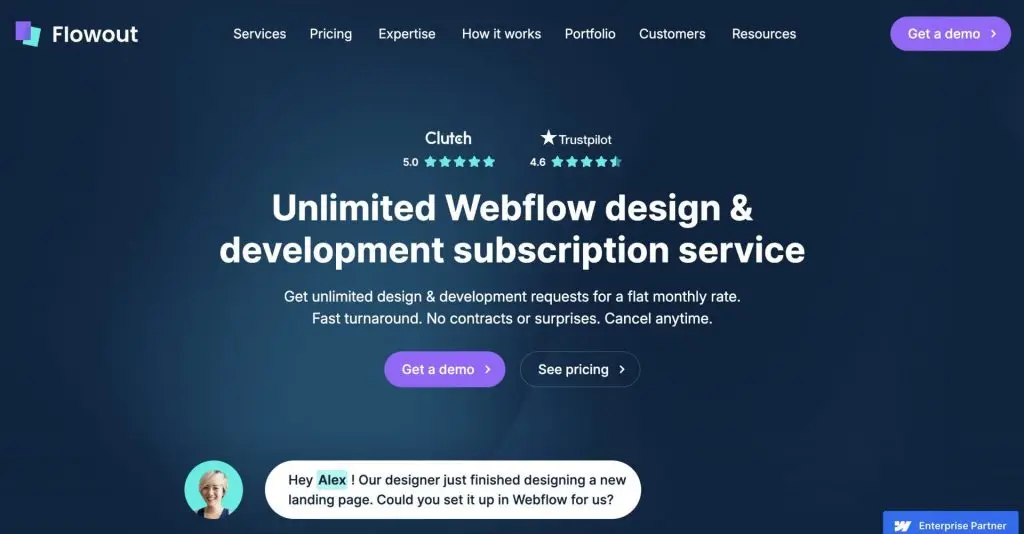
Real-Life Success Stories: Web Design Agencies Growing with Google Ads
Google Ads has proven to be a powerful tool for web design agencies to attract high-value clients and grow their businesses.
By leveraging targeted campaigns, creative ad strategies, and optimized landing pages, agencies can effectively connect with businesses in need of professional web design services.
Here are three specific success stories of web design agencies thriving with Google Ads.
Creative Pixel: Capturing Local Small Business Clients
Background: Creative Pixel, a small web design agency, wanted to grow its client base by targeting local small businesses looking to establish an online presence. They had limited visibility in their area, and traditional advertising methods weren’t yielding results.
Strategy Implemented:
- Created a location-based Google Ads campaign targeting keywords like “web design agency near me” and “small business website design [city name].”
- Developed ad copy emphasizing affordability and quick turnaround, such as “Affordable Websites for Local Businesses – Starting at $999.”
- Set up location extensions to highlight proximity and attract local traffic.
Results Achieved:
- Increased website traffic by 300% within three months.
- Acquired 15 new local clients in the first quarter, boosting revenue by 40%.
- Strengthened brand recognition in their local market.
NextGen Web Solutions: Scaling with E-commerce Clients
Background: NextGen Web Solutions, a mid-sized agency specializing in e-commerce website design, wanted to attract high-value clients from the retail sector. Their goal was to establish themselves as experts in building scalable online stores.
Strategy Implemented:
- Focused on high-intent keywords like “e-commerce website developer” and “Shopify website design agency.”
- Used video ads showcasing their portfolio, including before-and-after examples of e-commerce sites they redesigned.
- Implemented remarketing campaigns to re-engage users who visited their portfolio or pricing pages.
Results Achieved:
- Secured three large e-commerce clients within six months, each bringing six-figure contracts.
- Reduced cost-per-lead by 25% through improved ad targeting and remarketing efforts.
- Positioned the agency as a go-to solution for e-commerce businesses in their region.
Studio Elevate: Doubling Leads with Industry-Specific Targeting
Background: Studio Elevate, a boutique web design agency, wanted to attract niche clients in the healthcare and legal sectors. They aimed to demonstrate their expertise in creating compliant and user-friendly websites for these industries.
Strategy Implemented:
- Built campaigns targeting niche keywords like “healthcare website design” and “law firm website developer.”
- Created industry-specific landing pages featuring tailored case studies and testimonials from healthcare providers and legal professionals.
- Used callout extensions to highlight their experience with industry-specific requirements, such as HIPAA compliance for healthcare sites.
Results Achieved:
- Doubled their lead volume in under four months.
- Improved conversion rates by 35% due to highly relevant ad copy and landing pages.
- Secured long-term contracts with three major healthcare organizations and two large law firms.
